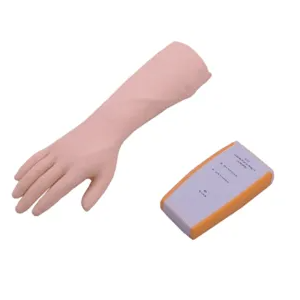13-01-2025
ADA MED SUPPLY LIMITED
Article tag: Wrist Joint puncture model Joint Puncture model BIX-CK20137
Wrist puncture is a common procedure in many clinical Settings, especially for treatments such as joint fluid extraction and drug injection. Due to the complex and dense anatomy of the wrist, precise puncture techniques are essential to avoid complications and improve treatment outcomes. Does the advanced wrist puncture model, as a simulation device, truly reflect the complexity of this procedure? Here is an analysis of the problem.
1. Accurate anatomical simulation
Modern wrist puncture models can highly reproduce the shape of the joint cavity and its surrounding tissues by accurately replicating the anatomy of the wrist. The model typically includes details such as joint capsules, ligaments, blood vessels and nerves, allowing students to operate in a near-real environment. Through this simulation design, students are able to fully understand the anatomical layout of the wrist joint and help it avoid damaging important structures during clinical operation.

2. Real piercing feedback
The advanced wrist piercing model uses materials with tactile feedback that simulate the different textures of skin, muscle, and joint cavities. Students can feel the resistance to penetrate different tissues during the piercing, which is important to simulate the different touch of the needle through the skin, muscle and joint capsule. This feedback helps students to better judge the depth and Angle of the puncture and improve the accuracy of the operation.
3. Simulate clinical complications
Clinical wrist joint puncture often encountered some special conditions, such as excessive fluid accumulation in the joint, changes in the structure of the joint cavity or the patient's position. The Advanced piercing model can help students practice coping strategies in advance by simulating these complex situations. For example, the model can adjust the amount of fluid in the joint cavity or change the structure through a specific setting, so that students can respond to various changes in training and improve the ability to adapt in practice.
4. Data support and evaluation
Modern wrist puncture models are often equipped with data acquisition and analysis systems that document the patient's procedure. These data include the success rate of puncture, operation time, puncture accuracy and other key indicators, through the data feedback, students can clarify their own level of operation, and then make targeted improvements. Studies have shown that trainees trained with this device are typically 20-30% more successful at operating in the clinic.
Data support:
One study showed that participants trained using the wrist piercing model had a 28 percent higher puncture success rate than traditional training methods. In addition, the success rate of the first piercing in clinical practice was significantly improved, and the puncture time was reduced by approximately 15%.
The wrist puncture model can effectively simulate the complexity of clinical puncture through highly simulated anatomy and precise haptic feedback. It not only provides a safe training platform for trainees, but also helps improve operational accuracy and success rate through data support. As an important training device in medical technology, wrist puncture model is undoubtedly a powerful tool to improve clinical operation skills, reduce medical risks and improve treatment results.